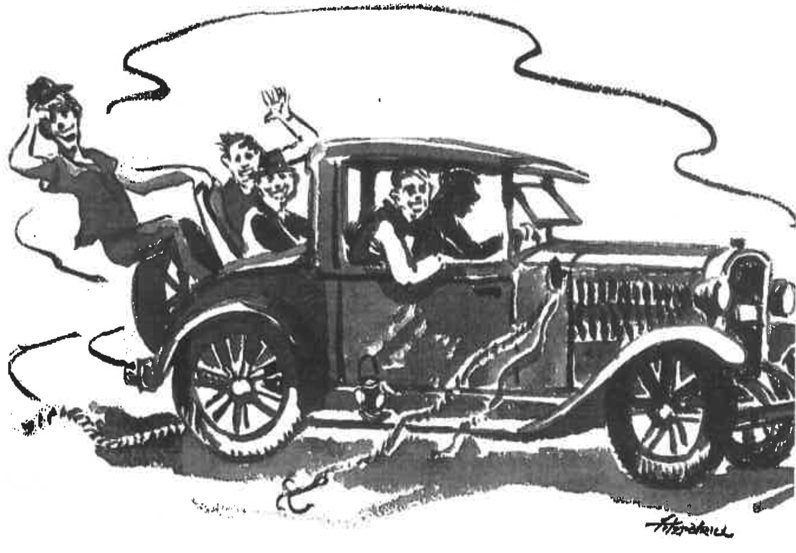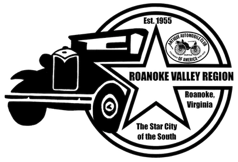RVR AACA: Stories
My First Vehicle
1925 Essex Coupe by Jim F.
The badge on the radiator said, “Essex Super Six”. It was my first car or mine and my brother Pete's first car. It was in the late 40's and we had been able to get our license at age 15. The war was just over and since the boys, who were over 18 years of age, were in the military, younger men had been needed to drive trucks and farm machinery, so age 15drivers were allowed. Now Pete and I palled around and did more hands-on stuff than our older brother, Bob. Bob likes books and chemistry. He was a born chemist. Before he was 12, he demonstrated rather forcefully his love for science. He had his own bedroom, while Peter and I had to share one. While madly pursuing his scientific traits, he mixed up a potent concoction in his bedroom and upon pouring the last liquid into the beaker; it then blew up and threw an ugly mess onto the ceiling and walls of his room. The stuff oozed down the walls and left ugly stains which my father refused to paint over, so it would stay there and be a lasting reminder to him to not do this again.
We didn't buy the car because it was an antique (which it certainly was), and we didn't buy it because we were enamored by Essex (which was built by Hudson). We bought it because it was a car and priced within our mean. Well, almost within our means. It was $15 and we together had $12. The last $3 seemed hard to come by (minimum wage was .35 an hour), but we scraped it up, however. We went over to Stiff's Drug Store on 11th Street, N.W.; paid the ole Dr. Stiff and got the thing (which was around back in the alley). I have no recollection of how we got the thing home. Did I mention that for $15 we bought a car that was not running?
Well, we thought, no problem. As we had been told that it used to run, and someone had the engine redone but hadn't quite finished putting the thing back together. We never ran away from a challenge and looked at every problem and dismissed it by saying “no problem”. Well, “no problem” turned out to be several various problems. Getting an old car that was not running home from a way across town must have been some sort of problem, but I can't recall how it was done.
I said, “we took it home,” but that is not accurate. We could not take it home as our father had forbidden us to buy a car. He had no idea we were considering buying a car right now, but he did know several things about buying any car that we might consider is: (1) that it had to be an old car‐-very old and very dilapidated to be in our price range, (2) that being very old and dilapidated it would be mechanically unsafe and a clear and present danger to ourselves and others, and (3) he knew that since whatever we bought would take every penny we had; that the car would be uninsured. Back then insurance was not required and to our teenaged minds, no requirement equals no problem. We reasoned it was Dad's fault anyway because we were a one-car family and he being a salesman took the car on business trips Monday through Friday leaving us to our own devices which usually meant walking. All of which turned out to be true. No problem! Our friend Al Stuart said that there was a garage behind his house that was empty, and we could use it. So, the car went over to Stuart's on Greenwood Road. Upon arrival at Greenwood Road, another problem arose. Apparently, Al Stuart had failed to advise his mother that we were planning to use her garage. From the look on Al's mother's face, it was obvious that she did not look with favor upon our plans. Actually, she was dead set against it, but somehow, she came around when we said it would be only a few days and we would have it running and take it away from there. She indicated that the farther away from there we could take it the happier she would be about it.
The next few weeks after school, the Stuart's garage was a beehive of activity. The work crew that arrived there was equally divided. Half of the boys under 15 and too young to drive, and the other half had licenses but were driving just barely, but nowhere in the whole bunch, was there anyone who knew the first thing about how automobiles worked. We found the fuel pump. It was a vacuum pump about the size and shape of a full quart tomato juice can. We bolted it to the firewall, and we got a set of spark plugs wires from Advance Stores and installed them. We filled the fuel pump with gas and ran the battery down grinding on the starter. We then pushed it and pulled it and ran it downhills, but it never came to life. We cranked it and cussed it and held up traffic with it, but it never started. Finally, frustrated and disgusted, we came to a realization that we were going to have to seek expert advice on this project. The next afternoon, six out-of-breath boys pushed the Essex into a neighborhood filling station and asked the mechanic why this car would not run. The mechanic looked at us and the car with obvious disapproval and said he would take a look. Upon lifting the hood up, he immediately spotted a problem and said “here's one thing that's missing” six heads immediately ducked down to see where in the problem lay. “Right down here,” the mechanic said pointing to a space below the manifold. “Right there,” you need a carburetor! “A carburetor,” one boy asked a she dove into the rumble seat area and pulled out a bushel basket of parts? “What does one look like?” Well, it's brass and about twice the size of your fist and has some levers and holes in it. The mechanic fished about in the bushel basket saying here's the carburetor and some linkage and some other parts we'll need, and I believe we might be able to make it work.
We learned several things that day‐we learned what a carburetor was and that cars would not run without one, and we learned that having a car mechanic was a necessity and might be an indispensable friend, even though their help might cause you to depart with more ”dollars than the car costs in the first place.
The next big problem with the Essex came one Friday night when I was on my way to Salem to see my girlfriend. Without warning, the car cut off and I drifted over to the side of the highway as the lights dimmed and the car took on a mournful look.
Nothing I could do would coax it back to life, so I flagged down the next bus and went ahead with my date plans. It was before 5:00 am. Next morning, and I awoke to brother Pete's shaking me violently and saying, “where's the car?” John Whittle and I are going to Murder Hole today. Murder Hole is a cave over in the Catawba area. The roof of one of the big rooms in the cave collapsed years ago leaving a monstrous hole in the ground. Now, if you are industrious enough and half‐witted enough, you can climb down into the massive hole and then venture into other parts of the cave. It works like a magnet on teenage boys who are adventurous and fearless and may have a subliminal and unresolved death wish. I mumbled something from my half-awake brain and Pete disappeared with the knowledge that he could find the car by the side of the highway about four miles toward Salem.
Fast forward about 12 hours to 5 O'clock that afternoon and I'm walking east on Campbell Avenue in downtown Roanoke, when I hear the unmistakable roar of the Essex. It has an unmistakable sound and as it flashed through the intersection and out of sight. Around the corner, I saw brother Pete at the wheel, with John Whittle, riding shotgun. Sam Oakey was in the rumble seat with another guy I didn't immediately recognize and behind them was an idiot sitting on the spare tire and frantically holding onto the handle of the rumble seat like a bull rider coming out of a chute. There was a seemingly endless array of ropes, hooks, carbide lights everywhere, and one rope was dragging along behind the car like a giant tail. As unbelievable as this sight was, I calmly accepted it as part of our usual craziness, but the question uppermost in my mind was how did he get that car started? When I got home, that night my first question to Pete was what was wrong with the car. He said he found gas running out of the carburetor in a stream. Seems a jet had fallen out of the carburetor. Now a carburetor jet is not unlike a hypodermic needle. It's a long slender brass needle which sprays the gas up into the air intake where it atomizes into a mist and is sucked into the engine where the spark explodes it. I said you boys must have crawled on hands and knees for blocks looking for a needle by the roadside. I was unprepared for his answer. “No,” he said. We never found it, but I saw the car running you must have found it...I insisted. Nope. Not possible to find a part like that on short notice, so we improvised. If it hadn't been for the two women's garters and the huge hat pin you had stuck in the driver's side visor, we would have never fixed it. We cut a twig off a nearby tree and forced the hat pin down through it several times to make it like a soda straw, and wedged it in the hole where the jet was and screwed it in. We then drove off. I still couldn't believe it until he showed it to me and then I still couldn't believe it, but we drove it that way for at least a month until we could find a replacement. They are grown men now and our children dismiss this story as a big lie like the story (when I was a boy, I had to walk three miles to school in the snow uphill both ways.)
I don't know how many years we kept the Essex, but it went away with a flare. Antifreeze was expensive and we couldn't afford that, but we found alcohol was cheap and alcohol won't freeze. So, alcohol it was, and it worked. We filled the radiator with it. The only caveat about alcohol is that it also burns, Brother Pete worked on the generator which is in close proximately to the vacuum fuel pump. He ran the car dry and brother Jim wanted to go somewhere and he had to get some gas and put it into the vacuum fuel pump to prime it. In his haste, he spilled some gas which found its way into the generator because brother Pete had left the cover off. Brother Jim started off and before reaching the corner, he noticed a strange illumination coming from under the hood. The spilled gasoline has ignited and started a small fire. As Jim jumped out of the car to try to put out the small fire, it became a big fire as the radiator hose melted and the alcohol spewed out and into the flames. In one big whoosh, the flames reached as high as the overhead wires and the night lit up like daylight. Somebody called the fire department which was there in minutes with sirens blaring. Traffic was stopping as much as a block away as curious drivers and neighbors flocked to watch the spectacle. It was a huge neighborhood bond fire. It was the kind of thing that in a quiet neighborhood really endears you.



